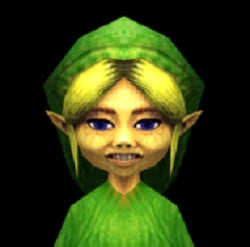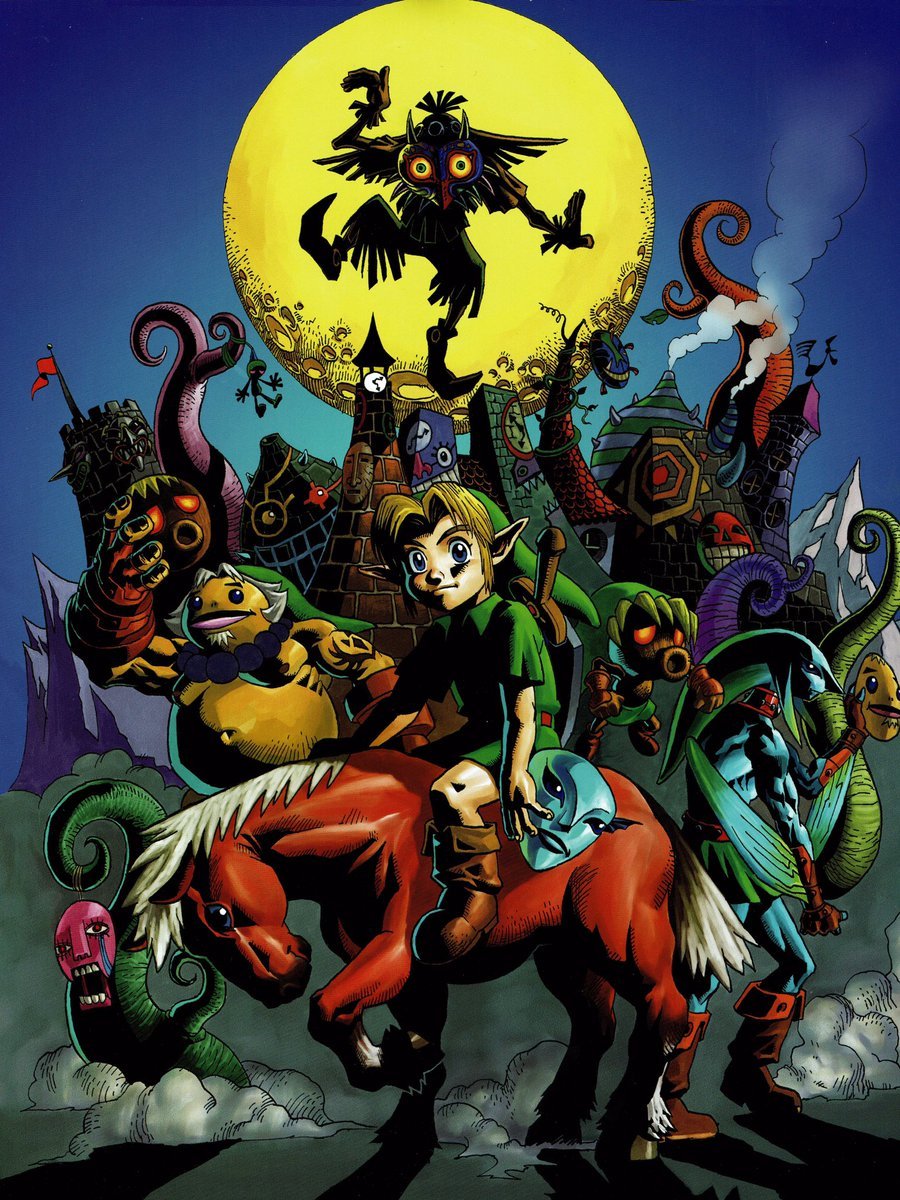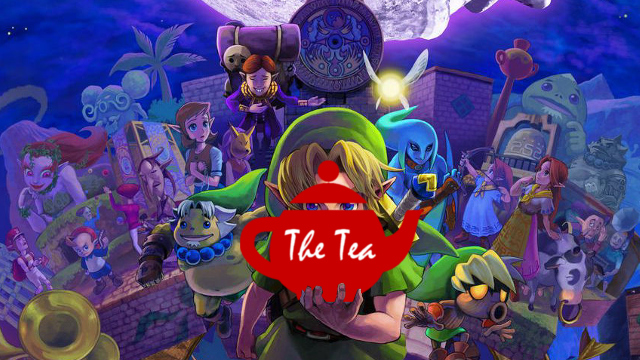I picked up Majora’s Mask sometime last year. It was my first Legend of Zelda game. Like, ever.
For a long time, not-playing Zelda was kind of a point of pride for me, and also just a killer fun fact for “Never Have I Ever.” But finally, after Majora got its 3DS remake, I decided to see what all the hype was about. It was only after I stumbled through my first three apocalyptic days in Termina that literally everyone (including my boss) told me that I’d chosen what might be the least accessible entry-point in a franchise that spans three decades.
There are a million Zelda games to choose from, and I had to pick the one in the bizarro off-shoot timeline, with the Hell clock and the dead-eyed statues and the cow-stealing aliens.
Apparently, Ocarina of Time (essentially the host body off of which Majora propagated) would’ve been a slightly better first choice, but it hadn’t even occurred to me that the two were connected. I thought Zelda was an anthology series. Y’know, like American Horror Story or something.
But apparently, it’s exactly like American Horror Story in the sense that anyone can retroactively connect the dots of the whole franchise and, if you squint hard enough, it makes a whole picture.
And Lord, what a picture Majora made.
If at first you don’t succeed… Die, die again
 I initially gravitated toward Majora because of a little story called “Ben Drowned.” Maybe you’ve heard of it? It’s one of the worst Creepypastas to ever infect the internet, convincing children around the world (myself included) that their Nintendo 64 cartridges could not only be dusty, but also demonic.
I initially gravitated toward Majora because of a little story called “Ben Drowned.” Maybe you’ve heard of it? It’s one of the worst Creepypastas to ever infect the internet, convincing children around the world (myself included) that their Nintendo 64 cartridges could not only be dusty, but also demonic.
Now that I’ve grown out of my internet horror phase (and am definitely not still terrified of Slenderman), I have the distance to see “Ben Drowned” as just a goofy ghost story. But at the time, it messed me up, and maybe turned me off Zelda until I could work through that phobia to find more mature things to be scared of. Like my electric bill. Or spiders.
By comparison, Majora itself isn’t so scary. It’s full of campy, cartoony moments, and it populates its world with weirdos who will send you on more errands than a full morning of Animal Crossing. Of course, all of the comings and goings happen under the looming threat of the moon’s collision course with Termina. But even knowing that they’re all high-key doomed at the end of the three-day cycle, the quirky residents of Clock Tower Town carry on, business as usual.
These mundane, personal moments really force you to care about the lives you’re supposed to be saving, and give a much greater weight to the adventure on the whole. If if the moon is super ugly. I mean, just look …

To be honest, if I knew the world was going to end in three days, you know what I’d do? I’d set my alarm to get up on time. I’d eat the same cereal I eat every morning. I’d drive to work and chat with my friends and go grocery shopping and probably stay up too late playing video games. To cling to a routine is deeply human. It’s a point of stability, even when things are hopeless.
So I get it …
But boy are they hopeless. Link takes it upon himself to help the people he meets, knowing that anything he does for them will inevitably be reset before the end of the three days. The swamp will become toxic again. The music box girl’s father will re-mummify. Anju and Kafei, after finally being reunited and resolving to die together, will be torn apart. And yet, we keep helping them, again and again, knowing it might be fruitless, because it’s the only thing you can do.
This game exists in the difference between “hopeless” and “meaningless.” It is enough that these characters have these fleeting scraps of happiness. It is enough that the world is as it should be, if only for a moment.
So yeah, maybe the game isn’t scary. But geez, it can get heavy.
Song of “X-Y-R-X-Y-R”
Of course, aside from the three-day doom cycle, Majora is best known for the masks. Y’know, it’s kind of right there in the title.
On the surface, they’re just mechanical spice for the gameplay. Each one serves a different function, from granting the gift of speed to acting as a cow-shaped entry-ticket to the most exclusive Milk Bar in Termina. Three special masks, however, transform Link completely from a human to one of the other three primary races in the game.
And the only way to get those is to play the “Song of Healing” on a corpse.
Link, it stands to reason, should not go into the medical field if that’s his idea of “healing.”
Instead of bringing back the dead, the Ocarina condenses their likenesses down to masks that encapsulate the identities of the departed. People literally mistake Link for whichever dead guys he’s masquerading as, and he just kind of rolls with it. The game doesn’t frame this as identity theft, but as a thoughtful tribute. For each, Link chooses to carry on the parts of their lives that were left unfinished.
 The only form Link doesn’t take on voluntarily is that of the Deku. Instead, it’s forced onto him at the beginning of the game in a horrific transformation sequence, one that sets the tone for the rest of the adventure. Unlike the mighty Goron or the sleek Zora, the Deku doesn’t feel like a power-up. We’re used to Link as a strong, able-bodied hero. To turn him into a little impish tree-dude feels like a limitation, at least at first.
The only form Link doesn’t take on voluntarily is that of the Deku. Instead, it’s forced onto him at the beginning of the game in a horrific transformation sequence, one that sets the tone for the rest of the adventure. Unlike the mighty Goron or the sleek Zora, the Deku doesn’t feel like a power-up. We’re used to Link as a strong, able-bodied hero. To turn him into a little impish tree-dude feels like a limitation, at least at first.
But even after Link is transformed back into the tights-clad hero we know and love, he keeps the Deku mask to use throughout the adventure. Eventually, we see the Deku not for its limitations, but for its unique strengths. With its light, feathery body, the Deku can ride the wind currents or even skip across the surface of water. By the time we run into the Deku Butler, who implies that his dead son is the source of the Deku mask itself, we can better appreciate Link’s role in honoring that image.
Majora’s themes of remembrance hit me hard every step of the way, especially as I find myself missing my own deceased loved ones in similarly tangible ways. Every day, I wear my uncle’s too-big golf jacket to work. And when I go home, I can feel the cool kitchen tile through my grandpa’s hand-me-down socks, whose heels he wore thin after decades and decades of standing at work.
These are small things, which maybe didn’t mean much while my uncle and grandpa were alive, but now they’re little pieces of them that I can take with me throughout the day. The masks of Majora embodied that for me on the screen in a way that felt deeply personal. Link isn’t dressing up as these three characters. He’s honoring their memory.
Fandom Freak-Out: Terrible Fate
The masks I’m referring to here, of course, are the dope power-up ones. Not the titular Mask, which was just a huge asshole to everyone, though I have to give kudos to Majora for breaking the usual big-bad mold.
The vicious spirit of the mask is no dark lord Ganondorf or even bumbling Bowser. It has no ambition for domination, no craving for power. It only desires suffering. And what better puppet for a chaotic demon than a trouble-making brat? Give godlike powers to any child, and they could easily become Skull Kid, one of the most compelling video game villains I’ve recently thrown down with. Which leads me to my freak-out of the week.
“Terrible Fate” is a beautifully rendered cinematic of the events leading up to Skull Kid’s possession. Here, we’re introduced to him not as the OP little demon who turned us into a Deku, but as a scared and lonely kid who got caught with his hand in a cosmically malevolent cookie jar.
It also answers the age-old question: do Skull Kids actually have beaks? Spoiler: no.
Final Swallow
Majora’s Mask was a frustrating, often obtusely intricate maze, one that I needed a walkthrough to navigate at almost every sharp turn. In the 25-ish hours I spent hobbling around Termina under the nightmare-fuel moon face, I don’t think I relaxed for even a second.
And I loved the crap out of it. Each heart-pounding tick of the clock was another unique beat in a lovingly dense world. I couldn’t wait for another dip into it, so I grabbed my old Wii from my parents’ house last weekend and now I’m neck-deep in the dungeons of Twilight Princess, which… I’m also told might not be the best representation of the series as a whole. But who cares! I’m living for it.
If these are the most difficult Zelda games to get into, then I’m looking forward to a long backlog of incredible adventures to come.
—
Questions for y’all: What was your first Zelda game? Did you find Majora charmingly weird or too-weird-to-be-charming? Why do the Great Fairies all wear the same outfits? These are the hot takes I need in the comments below.
Until next time, friends.
The Tea (never timely, always hot) is a weekly column steeped in gaming culture and the fandom experience. Tune in Thursdays for another cup of steamy content.







Published: Aug 1, 2018 09:00 pm